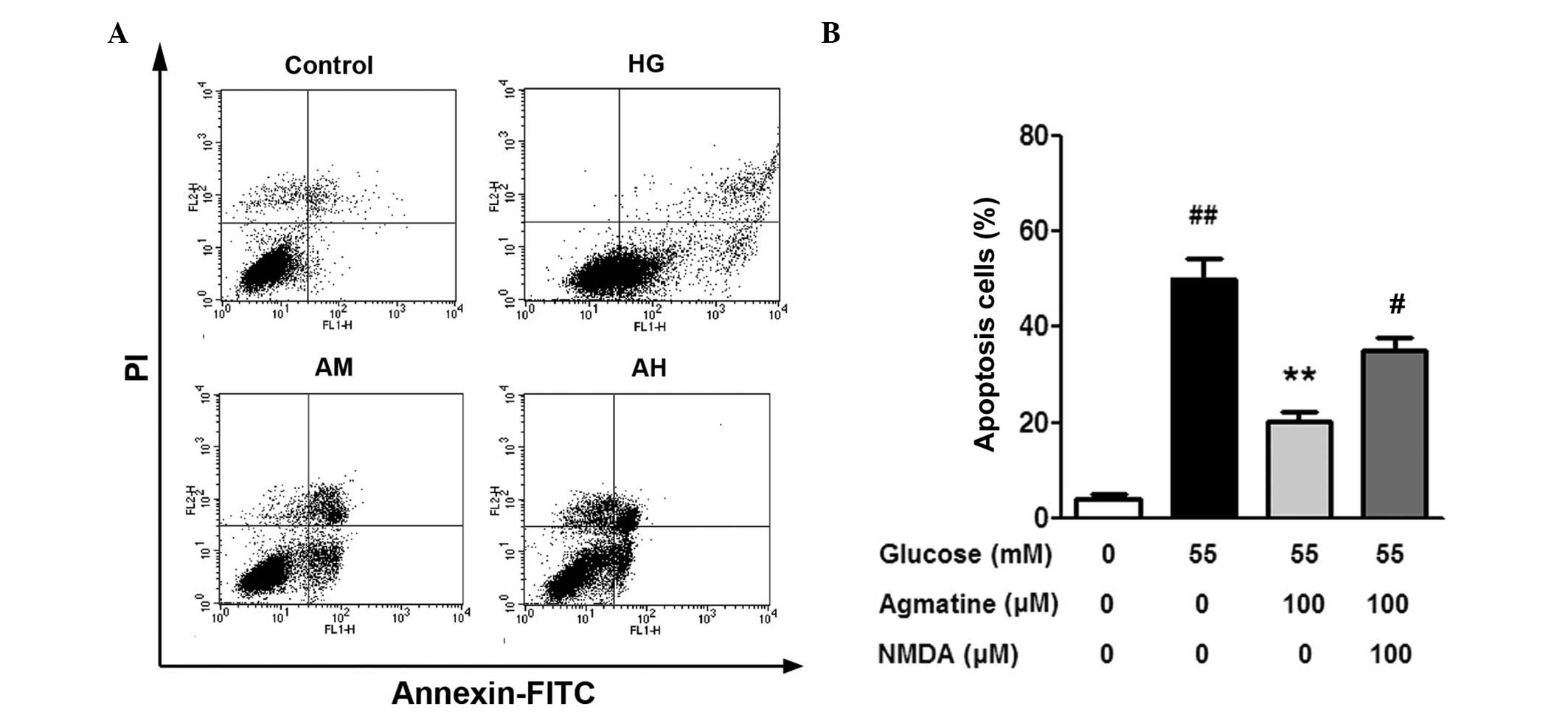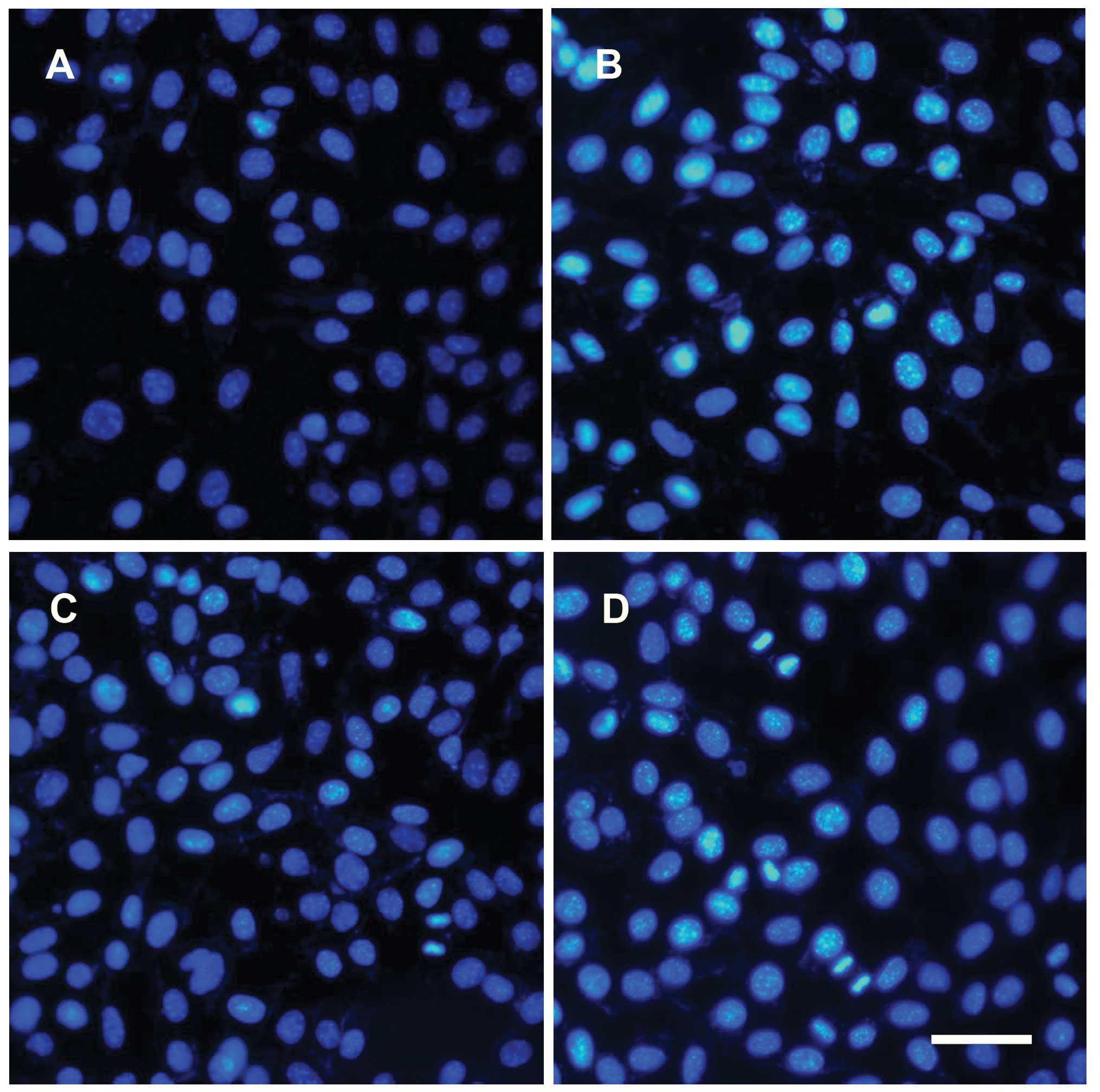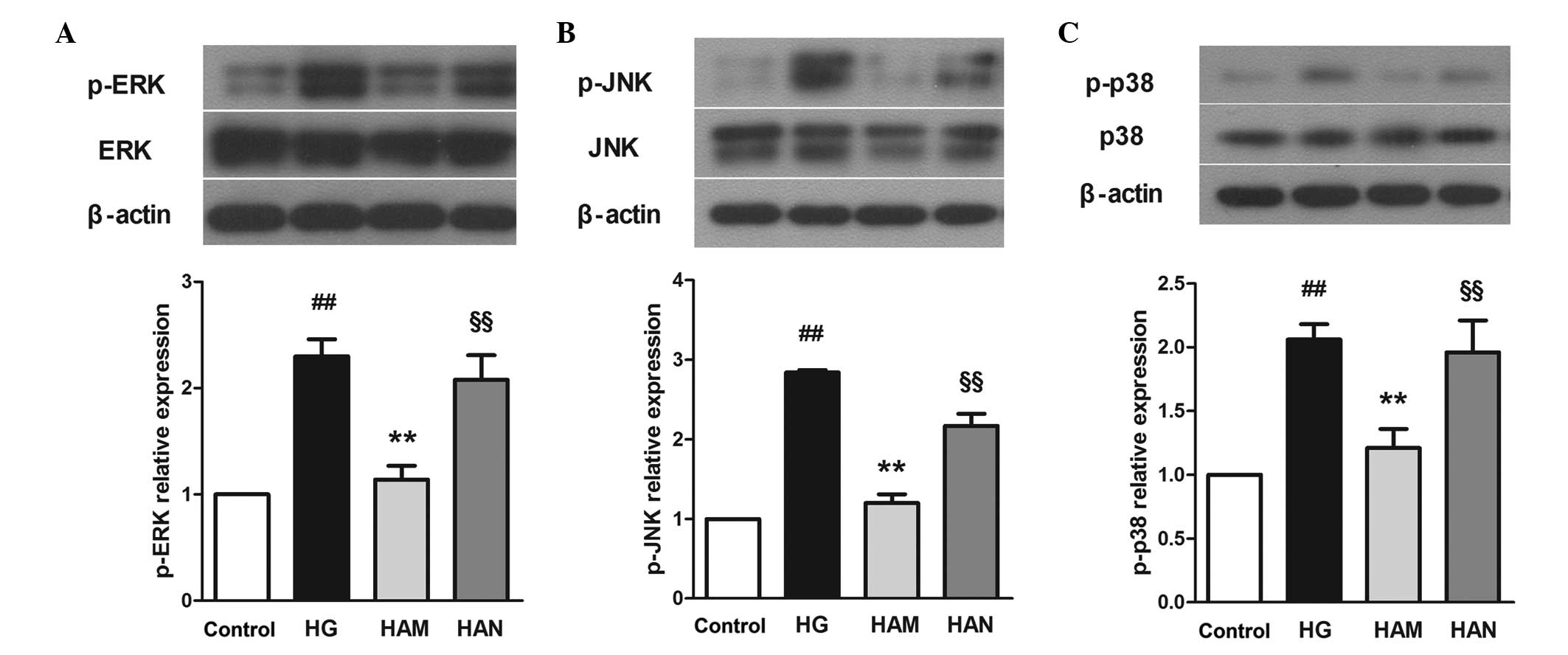|
1
|
Congdon N, O’Colmain B, Klaver CC, Klein
R, Muñoz B, Friedman DS, Kempen J, Taylor HR and Mitchell P: Eye
Diseases Prevalence Research Group: Causes and prevalence of visual
impairment among adults in the United States. Arch Ophthalmol.
122:477–485. 2004. View Article : Google Scholar : PubMed/NCBI
|
|
2
|
Lieth E, Gardner TW, Barber AJ and
Antonetti DA: Penn State Retina Research Group: Retinal
neurodegeneration: Early pathology in diabetes. Clin Experiment
Ophthalmol. 28:3–8. 2000. View Article : Google Scholar
|
|
3
|
Schellini SA, Gregório EA, Spadella CT,
Machado JL and de-Moraes-Silva MA: Müller cells and diabetic
retinopathy. Braz J Med Biol Res. 28:977–980. 1995.PubMed/NCBI
|
|
4
|
Newman E and Reichenbach A: The Müller
cell: A functional element of the retina. Trends Neurosci.
19:307–312. 1996. View Article : Google Scholar : PubMed/NCBI
|
|
5
|
Du JL, Xu LY and Yang XL: Glycine
receptors and transporters on bullfrog retinal Müller cells.
Neuroreport. 13:1653–1656. 2002. View Article : Google Scholar : PubMed/NCBI
|
|
6
|
Lewis GP, Erickson PA, Kaska DD and Fisher
SK: An immunocytochemical comparison of Müller cells and astrocytes
in the cat retina. Exp Eye Res. 47:839–853. 1988. View Article : Google Scholar : PubMed/NCBI
|
|
7
|
Linser P and Moscona AA: Induction of
glutamine synthetase in embryonic neural retina: Localization in
Müller fibers and dependence on cell interactions. Proc Natl Acad
Sci USA. 76:6476–6480. 1979. View Article : Google Scholar
|
|
8
|
Li Q and Puro DG: Diabetes-induced
dysfunction of the glutamate transporter in retinal Müller cells.
Invest Ophthalmol Vis Sci. 43:3109–3116. 2002.PubMed/NCBI
|
|
9
|
Kowluru RA, Engerman RL, Case GL and Kern
TS: Retinal glutamate in diabetes and effect of antioxidants.
Neurochem Int. 38:385–390. 2001. View Article : Google Scholar : PubMed/NCBI
|
|
10
|
Lieth E, Barber AJ, Xu B, Dice C, Ratz MJ,
Tanase D and Strother JM: Glial reactivity and impaired glutamate
metabolism in short-term experimental diabetic retinopathy. Penn
State Retina Research Group. Diabetes. 47:815–820. 1998. View Article : Google Scholar : PubMed/NCBI
|
|
11
|
Barber AJ, Antonetti DA and Gardner TW:
Altered expression of retinal occludin and glial fibrillary acidic
protein in experimental diabetes. The Penn State Retina Research
Group. Invest Ophthalmol Vis Sci. 41:3561–3568. 2000.PubMed/NCBI
|
|
12
|
Rungger-Brändle E, Dosso AA and
Leuenberger PM: Glial reactivity, an early feature of diabetic
retinopathy. Invest Ophthalmol Vis Sci. 41:1971–1980.
2000.PubMed/NCBI
|
|
13
|
Li Q, Zemel E, Miller B and Perlman I:
Early retinal damage in experimental diabetes:
Electroretinographical and morphological observations. Exp Eye Res.
74:615–625. 2002. View Article : Google Scholar : PubMed/NCBI
|
|
14
|
Curtis TM, Hamilton R, Yong PH, McVicar
CM, Berner A, Pringle R, Uchida K, Nagai R, Brockbank S and Stitt
AW: Müller glial dysfunction during diabetic retinopathy in rats is
linked to accumulation of advanced glycation end-products and
advanced lipoxidation end-products. Diabetologia. 54:690–698. 2011.
View Article : Google Scholar
|
|
15
|
Zhong Y, Li J, Chen Y, Wang JJ, Ratan R
and Zhang SX: Activation of endoplasmic reticulum stress by
hyperglycemia is essential for Müller cell-derived inflammatory
cytokine production in diabetes. Diabetes. 61:492–504. 2012.
View Article : Google Scholar : PubMed/NCBI
|
|
16
|
Walker RJ and Steinle JJ: Role of
beta-adrenergic receptors in inflammatory marker expression in
Müller cells. Invest Ophthalmol Vis Sci. 48:5276–5281. 2007.
View Article : Google Scholar : PubMed/NCBI
|
|
17
|
Tabor CW and Tabor H: Polyamines. Annu Rev
Biochem. 53:749–790. 1984. View Article : Google Scholar : PubMed/NCBI
|
|
18
|
Li G, Regunathan S, Barrow CJ, Eshraghi J,
Cooper R and Reis DJ: Agmatine: An endogenous clonidine-displacing
substance in the brain. Science. 263:966–969. 1994. View Article : Google Scholar : PubMed/NCBI
|
|
19
|
Otake K, Ruggiero DA, Regunathan S, Wang
H, Milner TA and Reis DJ: Regional localization of agmatine in the
rat brain: An immunocytochemical study. Brain Res. 787:1–14. 1998.
View Article : Google Scholar : PubMed/NCBI
|
|
20
|
Reis DJ, Yang XC and Milner TA: Agmatine
containing axon terminals in rat hippocampus form synapses on
pyramidal cells. Neurosci Lett. 250:185–188. 1998. View Article : Google Scholar : PubMed/NCBI
|
|
21
|
Raasch W, Schäfer U, Chun J and Dominiak
P: Biological significance of agmatine, an endogenous ligand at
imidazoline binding sites. Br J Pharmacol. 133:755–780. 2001.
View Article : Google Scholar : PubMed/NCBI
|
|
22
|
Piletz JE, Chikkala DN and Ernsberger P:
Comparison of the properties of agmatine and endogenous
clonidine-displacing substance at imidazoline and alpha-2
adrenergic receptors. J Pharmacol Exp Ther. 272:581–587.
1995.PubMed/NCBI
|
|
23
|
Yang XC and Reis DJ: Agmatine selectively
blocks the N-methyl-D-aspartate subclass of glutamate receptor
channels in rat hippocampal neurons. J Pharmacol Exp Ther.
288:544–549. 1999.PubMed/NCBI
|
|
24
|
Satriano J, Kelly CJ and Blantz RC: An
emerging role for agmatine. Kidney Int. 56:1252–1253. 1999.
View Article : Google Scholar : PubMed/NCBI
|
|
25
|
Iizuka Y, Hong S, Kim CY, Kim SK and Seong
GJ: Agmatine pretreatment protects retinal ganglion cells (RGC-5
cell line) from oxidative stress in vitro. Bio cell. 32:245–250.
2008.
|
|
26
|
Iizuka Y, Hong S, Kim CY, Yang WI, Lee JE
and Seong GJ: Protective mechanism of agmatine pretreatment on
RGC-5 cells injured by oxidative stress. Braz J Med Biol Res.
43:356–358. 2010. View Article : Google Scholar : PubMed/NCBI
|
|
27
|
Park YM, Lee WT, Bokara KK, Seo SK, Park
SH, Kim JH, Yenari MA, Park KA and Lee JE: The multifaceted effects
of agmatine on functional recovery after spinal cord injury through
Modulations of BMP-2/4/7 expressions in neurons and glial cells.
PLoS One. 8:e539112013. View Article : Google Scholar : PubMed/NCBI
|
|
28
|
Ahn SK, Hong S, Park YM, Choi JY, Lee WT,
Park KA and Lee JE: Protective effects of agmatine on
lipopolysac-charide-injured microglia and inducible nitric oxide
synthase activity. Life Sci. 91:1345–1350. 2012. View Article : Google Scholar : PubMed/NCBI
|
|
29
|
Uchihori Y and Puro DG: Glutamate as a
neuron-to-glial signal for mitogenesis: Role of glial
N-methyl-D-aspartate receptors. Brain Res. 613:212–220. 1993.
View Article : Google Scholar : PubMed/NCBI
|
|
30
|
Mysona BA, Al-Gayyar MM, Matragoon S,
Abdelsaid MA, El-Azab MF, Saragovi HU and El-Remessy AB: Modulation
of p75(NTR) prevents diabetes- and proNGF-induced retinal
inflammation and blood-retina barrier breakdown in mice and rats.
Diabetologia. 56:2329–2339. 2013. View Article : Google Scholar : PubMed/NCBI
|
|
31
|
Piletz JE, Aricioglu F, Cheng JT,
Fairbanks CA, Gilad VH, Haenisch B, Halaris A, Hong S, Lee JE, Li
J, et al: Agmatine: Clinical applications after 100 years in
translation. Drug Discov Today. 18:880–893. 2013. View Article : Google Scholar : PubMed/NCBI
|
|
32
|
Olmos G, DeGregorio-Rocasolano N, Paz
Regalado M, Gasull T, Assumpció Boronat M, Trullas R, Villarroel A,
Lerma J and García-Sevilla JA: Protection by imidazol(ine) drugs
and agmatine of glutamate-induced neurotoxicity in cultured
cerebellar granule cells through blockade of NMDA receptor. Br J
Pharmacol. 127:1317–1326. 1999. View Article : Google Scholar : PubMed/NCBI
|
|
33
|
Hong S, Kim CY, Lee JE and Seong GJ:
Agmatine protects cultured retinal ganglion cells from tumor
necrosis factor-alpha-induced apoptosis. Life Sci. 84:28–32. 2009.
View Article : Google Scholar
|
|
34
|
Hong S, Lee JE, Kim CY and Seong GJ:
Agmatine protects retinal ganglion cells from hypoxia-induced
apoptosis in transformed rat retinal ganglion cell line. BMC
Neurosci. 8:812007. View Article : Google Scholar : PubMed/NCBI
|
|
35
|
Zhu MY, Wang WP and Bissette G:
Neuroprotective effects of agmatine against cell damage caused by
glucocorticoids in cultured rat hippocampal neurons. Neuroscience.
141:2019–2027. 2006. View Article : Google Scholar : PubMed/NCBI
|
|
36
|
Kawabata H, Setoguchi T, Yone K, Souda M,
Yoshida H, Kawahara K, Maruyama I and Komiya S: High mobility group
box 1 is upregulated after spinal cord injury and is associated
with neuronal cell apoptosis. Spine (Phila Pa 1976). 35:1109–1115.
2010.
|
|
37
|
McNearney TA, Ma Y, Chen Y, Taglialatela
G, Yin H, Zhang R and Westlund KN: A peripheral neuroimmune link:
Glutamate agonists upregulate NMDA NR1 receptor mRNA and protein,
vimentin, TNF-alpha, and RANTES in cultured human synoviocytes. Am
J Physiol Regul Integr Comp Physiol. 298:R584–R598. 2010.
View Article : Google Scholar
|
|
38
|
Kern TS and Barber AJ: Retinal ganglion
cells in diabetes. J Physiol. 586:4401–4408. 2008. View Article : Google Scholar : PubMed/NCBI
|
|
39
|
Hanahan D and Weinberg RA: The hallmarks
of cancer. Cell. 100:57–70. 2000. View Article : Google Scholar : PubMed/NCBI
|
|
40
|
Vaux DL, Cory S and Adams JM: Bcl-2 gene
promotes haemopoietic cell survival and cooperates with c-myc to
immortalize pre-B cells. Nature. 335:440–442. 1988. View Article : Google Scholar : PubMed/NCBI
|
|
41
|
Ola MS, Nawaz M and Ahsan H: Role of Bcl-2
family proteins and caspases in the regulation of apoptosis. Mol
Cell Biochem. 351:41–58. 2011. View Article : Google Scholar : PubMed/NCBI
|
|
42
|
Wei MC, Zong WX, Cheng EH, Lindsten T,
Panoutsakopoulou V, Ross AJ, Roth KA, MacGregor GR, Thompson CB and
Korsmeyer SJ: Proapoptotic BAX and BAK: A requisite gateway to
mitochondrial dysfunction and death. Science. 292:727–730. 2001.
View Article : Google Scholar : PubMed/NCBI
|
|
43
|
Youle RJ and Strasser A: The BCL-2 protein
family: Opposing activities that mediate cell death. Nat Rev Mol
Cell Biol. 9:47–59. 2008. View Article : Google Scholar
|
|
44
|
Ghavami S, Hashemi M, Ande SR, Yeganeh B,
Xiao W, Eshraghi M, Bus CJ, Kadkhoda K, Wiechec E, Halayko AJ and
Los M: Apoptosis and cancer: Mutations within caspase genes. J Med
Genet. 46:497–510. 2009. View Article : Google Scholar : PubMed/NCBI
|
|
45
|
Ko HW, Park KY, Kim H, Han PL, Kim YU,
Gwag BJ and Choi EJ: Ca2+-mediated activation of c-Jun
N-terminal kinase and nuclear factor kappa B by NMDA in cortical
cell cultures. J Neurochem. 71:1390–1395. 1998. View Article : Google Scholar : PubMed/NCBI
|
|
46
|
Nicole O, Ali C, Docagne F, Plawinski L,
MacKenzie ET, Vivien D and Buisson A: Neuroprotection mediated by
glial cell line-derived neurotrophic factor: Involvement of a
reduction of NMDA-induced calcium influx by the mitogen-activated
protein kinase pathway. J Neurosci. 21:3024–3033. 2001.PubMed/NCBI
|
|
47
|
Munemasa Y, Ohtani-Kaneko R, Kitaoka Y,
Kuribayashi K, Isenoumi K, Kogo J, Yamashita K, Kumai T, Kobayashi
S, Hirata K and Ueno S: Contribution of mitogen-activated protein
kinases to NMDA-induced neurotoxicity in the rat retina. Brain Res.
1044:227–240. 2005. View Article : Google Scholar : PubMed/NCBI
|
|
48
|
Kundu S, Pushpakumar SB, Tyagi A, Coley D
and Sen U: Hydrogen sulfide deficiency and diabetic renal
remodeling: Role of matrix metalloproteinase-9. Am J Physiol
Endocrinol Metab. 304:E1365–E1378. 2013. View Article : Google Scholar : PubMed/NCBI
|


















